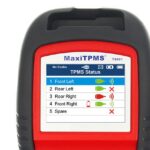The Evaporative Emission Control (EVAP) system prevents fuel vapors from escaping into the atmosphere. A crucial component in diagnosing EVAP issues is the VCDS (Vag-Com Diagnostic System), a powerful diagnostic tool for Volkswagen, Audi, Seat, and Skoda vehicles. This article delves into the intricacies of the EVAP system, common problems, and how to use VCDS for effective EVAP leak detection. Understanding these systems is vital for controlling greenhouse gas emissions and identifying potential tampering.
EVAP System Components and Functionality
The EVAP system comprises several key components:
- Leak Detection Pump (LDP): This vacuum-driven, ECM-controlled pump pressurizes the EVAP system to detect leaks. It can also function as the EVAP canister vent. The LDP plays a critical role in the Vcds Evap Test.
- Tank Leak Diagnostic Module (DM-TL): This module actively checks the canister purge valve by pressurizing the fuel tank and monitoring pressure decay. It utilizes an electric pump and a reference leak for accurate diagnosis.
- Natural Vacuum Leak Detection (NVLD): This system passively checks for leaks while the engine is off by monitoring pressure changes caused by temperature fluctuations. It relies on a pressure switch to detect leaks larger than 0.020 inches.
- Canister Purge Valve (N80): This valve controls the flow of fuel vapors from the charcoal canister to the engine intake manifold for combustion. The N80 is frequently tested during a VCDS EVAP test.
- Charcoal Canister: This component stores fuel vapors until they can be purged into the engine.
Performing a VCDS EVAP Test
VCDS offers specific test procedures for diagnosing EVAP system components:
- Output Tests: These tests activate individual components, such as the N80 purge valve and the LDP, allowing you to listen for proper operation and check for leaks.
- Measuring Values: VCDS displays live data from various sensors, enabling you to monitor system pressure, purge flow, and other relevant parameters during testing. This data is crucial for pinpointing the source of a leak.
Common EVAP System Problems and Diagnosis
Common EVAP issues include:
- Small Leaks: Often caused by loose gas caps, cracked hoses, or faulty seals. VCDS can pinpoint these leaks through pressure testing and component activation.
- Large Leaks: These leaks are usually more significant and may involve damaged components like the fuel tank or EVAP canister. Smoke testing in conjunction with VCDS can aid in diagnosis.
- Purge Valve Issues: A malfunctioning N80 valve can cause various driveability problems and trigger EVAP-related fault codes. VCDS output tests can confirm proper valve operation.
- LDP Malfunction: A faulty LDP can prevent the system from pressurizing properly, hindering leak detection. VCDS can activate the LDP to check for functionality.
Interpreting VCDS EVAP Test Results
Analyzing VCDS data is critical for accurate diagnosis. Pay close attention to:
- Fault Codes: Identify specific DTCs related to the EVAP system and research their potential causes.
- Measuring Values: Observe pressure changes during LDP activation and monitor purge flow during N80 operation. Deviations from expected values indicate potential problems.
- Output Test Results: Note any unusual noises or behaviors during component activation, suggesting potential malfunctions.
Importance of Proper EVAP System Maintenance
Regular maintenance can prevent EVAP issues:
- Inspect hoses and connections for cracks or damage.
- Ensure the gas cap is properly sealed.
- Replace the charcoal canister as recommended by the manufacturer.
By understanding the EVAP system and utilizing the diagnostic capabilities of VCDS, you can effectively identify and repair leaks, ensuring proper vehicle operation and minimizing environmental impact.

